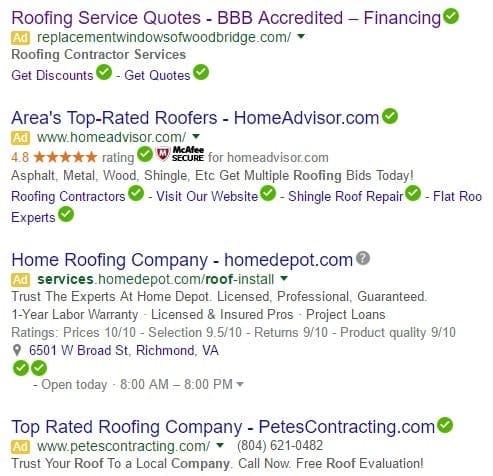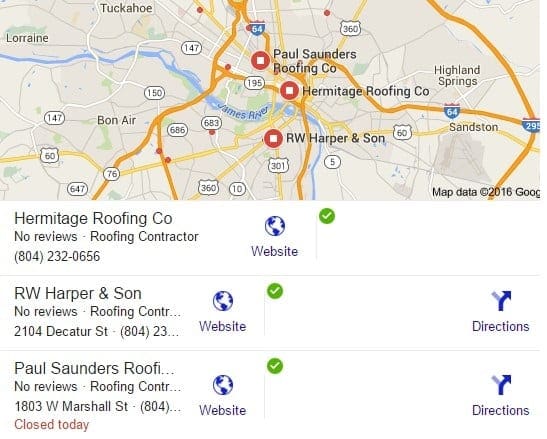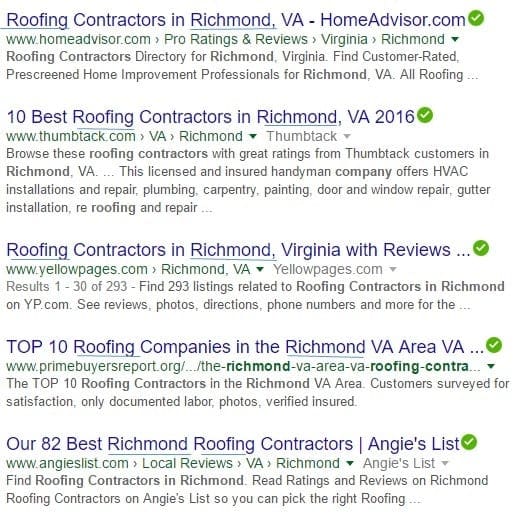A Simple ‘do it yourself’ Technique That Will Triple Your Website Leads, Practically Overnight
If there were ever a single marketing move that could potentially grow your business exponentially this would have to be it. And you’ll be shocked to know you can do this absolutely free, and in most cases, you won’t need any special expertise or technical experience, and at the very least your web developer can do this in just a few seconds. With that said, get a pen out and get ready to learn something all those SEO guys hoped you’d never find out about – we’re about to reveal some wonderful knowledge from our gurus.
For the sake of this presentation let’s just assume that you are the owner of a roofing company in Richmond, Virginia and your goal is to find online customers and get leads from your website. We’ll begin by showing you what the customer searching online is going to see and then what websites Google favors and places at the top of the search results (and why).
In the below example a user has just searched Google to find a roofing company located in Richmond VA and has typed in “roofing companies in Richmond, VA”. Seems like it would be easy enough to show up on page one of Google, but as you can see in the diagram below, Google has found 1,990,000 webpages that fit this description and they are only going to show the top 10 (in their opinion) on page 1. So if you’re not found within the first two pages then you might as well be on page 20,000 because very rarely does anyone ever scroll past the first page, let alone the second one.

In most cases Google is going to return three kinds of results. The first to be shown will be the paid ads (also called pay per click ads) usually consisting of four ads. These people are paying big bucks every time someone clicks on their ad, but studies have shown that only about 25% of users will click the paid search listings.

The next set of listings will be pulled from Google Places/Google Business pages and again only three listings will appear.

Good news – getting listed here is also free, but there’s no guarantee you’ll be included in the top three spots. Regardless, we highly recommend that you at least add your business. It takes about 5 minutes to set up, and when you’re done Google will mail you a post card with a PIN number on it, and after you receive it you’ll need to log back in to your account and enter the code to verify that you really have a physical location at the address you entered. Again, since it’s free, and it will pay off big time if they put you on top, you’d be crazy not to do it. You can sign up for Google business/Map pages here.
The last set of listings are called ‘organic’ listings, and though they are at the bottom, they actually dominate the percentage of clicks by end users. In most cases Google will display 10 organic search results that it believes best fits the users search query, and if you hope to be chosen as one of the top 10 then you better know what Google is looking at to make their decision – or at least what drives a large part of their decision. In the below diagram we see the top 5 websites that Google displayed after searching for “roofing companies in Richmond VA” and that blue line you see (the one you click on to go to their website) is called a TITLE TAG. If there was only thing you could ever learn about optimizing a website, this would be it. This single element basically says “hey Google, I’m a roofing company in Richmond, so please show my website first”. I can’t tell you how many businesses mistakenly only have a generic title tag that says something like “home page” or “services”, or just says the company name. Not convinced? I challenge you to perform any online search and see if you can find even one result returned that doesn’t have at least one (usually all) of the searcher’s keywords listed in the title tag. Let’s look at the image below where I searched for “roofing companies in Richmond, VA” and take notice of the keywords in each of title tags (I underlined the keywords)

Did you notice that not one of the title tags simply says ‘home page’ or just lists the company name? You could perform hundreds of thousands of Google searches and you’ll see this pattern over and over again. Yes, getting the right title tag is that important, and it actually takes less than 10 seconds to change it. So if it’s so easy and so effective, why isn’t everyone doing it? The answer is simple….the SEO companies don’t want you to know this powerful technique (because then you have pay handsomely for them to do it) so they’re not sharing it with anyone. As there are other factors that can go into ranking high on Google, we’re not implying that it’s a guaranteed slam dunk, but I can tell you that more often than not it gets the job done, especially in less competitive markets.
What’s The Right Title Tag to Use?
First let me be clear, every page on your website needs its own unique title tag and it must be relevant to what’s actually being discussed on the webpage – Google is smarter than you might think. So, a mortgage company in Chicago might have one page with the title tag set as ‘home mortgage loans in Chicago’, another page optimized for ‘refinance home mortgages in Chicago”, and yet another for ‘financing for commercial building loans’.
When attempting to choose the right title tag these are the key secrets to doing it right. 1) make sure to use the keywords that people are actually typing into the Google search bar. 2) if you operate on a local basis you simply must include your city name in the title tag. 3) Use the secret tool/technique, known as the allintitle: (explained below) search tool and find the least competitive terms and rank easier to gain more traffic (thus leads).
CHOOSING THE RIGHT KEYWORDS: If you own a roofing company you would naturally have pages with title tags containing keywords such as ‘roofers’, ‘roof repair’, and ‘cost for a new roof’. We recommend that you, and at least two other people, sit down and write 10 different ways people would search for your services online, and then compare notes and build title tags (and new pages if needed) that match what people are looking for. For example, it is very common to search for how much products and services cost, and thus you might need a webpage that talks about the cost of installing a new roof, which would also have a title tag like ‘how much does a new roof cost?” In other words, whatever people are typing into the Google search bar to look for your type of services, those terms are also defining the pages and title tags that simply must exist on your website.
KEEP IT LOCAL: If you own a roofing company in Houston then you need to include the word ‘Houston’ in your title tag (and in your webpage content). The reason you would do this is 1) you have no need for a lead in some far away city or state. 2) it’s easier to rank for a local term than it is a broad term. This is explained on a deeper level in the next section as we discuss the AllInTitle: tool.
THE AWESOME SEO TECHNIQUE KNOWN AS ‘ALLINTITLE: SEARCH’: One of closest guarded secrets by SEO firms is the use of an ‘AllInTitle:’ search which helps you to pick the right title tag by measuring the competition for specific keywords/phrases. What this technique does is it lets you see exactly how many webpages actually have the exact keywords in their title tag that you are competing for. The less competition, the easier it is to rank! To do this you simply go to Google.com and type in ‘AllInTitle:’ (without the quotes) and then type the keywords/title tag you are looking to compare competition levels for. Here’s an example of how a roofer in Houston might use this technique to narrow down his decision for picking the best title tag.
Example 1: Excessively competitive.
Here we go to Google.com and type in ‘allintitle:roofers’ and we see there are 358,000 webpages that have the word ‘roofers’ in their title tag. Let’s be honest, your odds of ranking for a search including just the word ‘roofers’ is not very good, and 99% of the traffic would be out of your service area anyway.

Example 2: Highly competitive.
Here we go to Google.com and type in ‘allintitle:roofers in Houston’ and we see there are 10, 200 webpages competing for this exact phrase in their title tag. Your odds of ranking on page one of Google for this term just got better, but are still highly competitive.

Example 3: Much Better match.
Here we go to Google.com and type in ‘allintitle:roofing companies in Houston’ and we see there are only 220 webpages competing for this exact phrase in their title tag. Your odds of ranking on page one of Google for this term are now incredibly better!

Example 4: Home Run!
Here we go to Google.com and type in ‘allintitle:cost of a new roof in Houston’ and we see there are only 7 webpages competing for this exact phrase in their title tag. Your odds of ranking on page one of Google for this term are almost guaranteed.

Final Notes: Again, whatever words are in your title tag must also be used in the content on that page. So if your title tag is “cost of a new roof in Houston” then that page should address the factors that impact the cost of a new roof in Houston, such as the square footage of a roof, cost of supplies, roof pitch, and how the types of shingles can change the price.
While this technique is incredibly effective and has proven time and time again to work, it is not 100% bulletproof. However, if your competitors are not employing this strategy you are almost guaranteed to out-rank them. Bottom line, this is a simple practice that has substantial benefits, and to capitalize on it we highly recommend that you build tons of webpages with good quality content addressing every possible question and/or search phrase that people might use to find information online about your product or service.
Did you find this article valuable? If so, there’s better stuff coming so make sure to share it with your business friends and colleagues and sign up for our newsletter for more amazing business tips and lead generation techniques sent directly to your inbox.